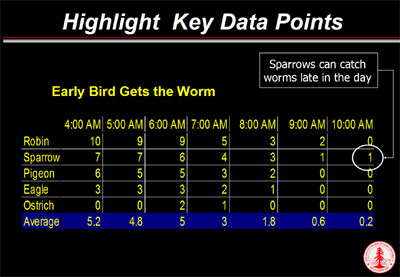|
|
 PowerPoint
Slide Content PowerPoint
Slide Content
|
|
|
Open up PowerPoint, and you get a whole... blank...
screen. Kind of intimidating, isn't it? What
the heck do you put on that slide - or for that matter,
all the subsequent ones? Where do you even start?
Well, after you've determined that you should Use
PowerPoint for your presentation, and chosen a Style
for your slides, here are some pointers for your slide
content:
-
What Can't Be Said - PowerPoint
is best for things that are difficult to communicate
verbally. This includes processes, concepts,
mechanisms, structures, heirarchies, photographs, any
kinds of graphs... There's a lot of stuff out
there! See the examples below, for a
"process" and a graph that do a good job of
communicating things that would be longer and more
difficult to merely verbalize...


-
Bring the Audience Closer -
When applicable, it's great to let an audience more
fully appreciate a topic by bringing it closer to
them. This mean showing photos, playing sounds
or videos. This is especially important in
vacation or venue presentations, where judgments or
opinions will be based on as close an experience as
possible to actually being there.
-
Things NOT To Do - There are a
LOT of things that PowerPoint can do that
should really never be done. Clip Art is perhaps
the most abused - cute little clipart really does
nothing for your speech. In fact, it can
severely distract the audience and undermine your
credibility - and it almost NEVER adds any value to
the speech. Don't use it. Other things to
avoid: sounds, annoying transitions, animations
(unless they're illustrating something useful),
endless lists of bullet points, and charts of raw data
- unless they have information specifically
"called out" on them, as shown below.

|

